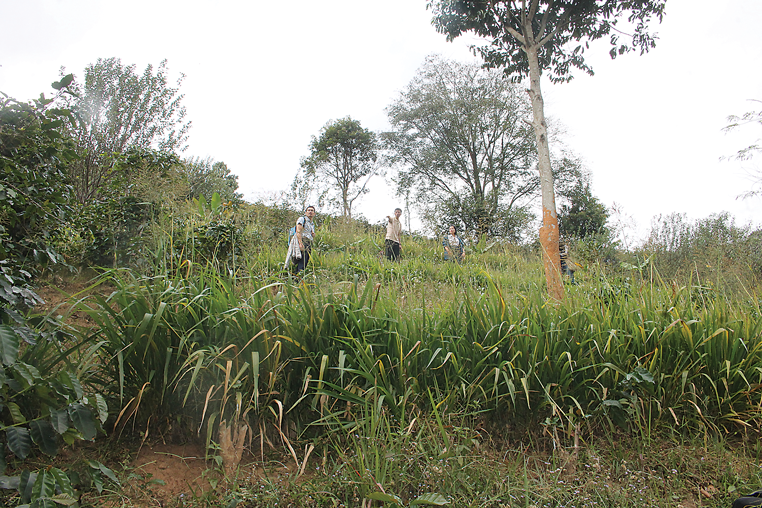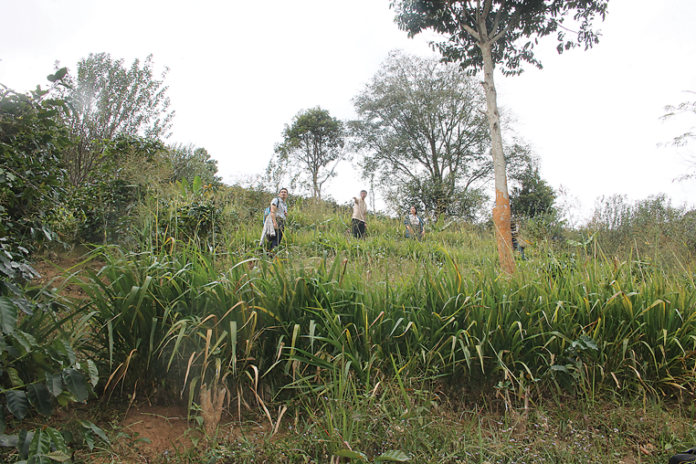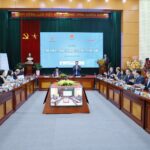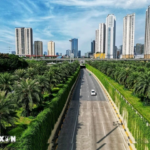## Eco-Agriculture: A Sustainable Approach to Vietnam’s Agricultural Challenges
Eco-agriculture is a nature-based farming method that utilizes little to no synthetic chemicals, such as chemical fertilizers, pesticides, or growth stimulants. Going beyond maximizing yield, eco-agriculture aims to reduce greenhouse gas emissions, protect land, water, and air resources, and maintain the vibrancy of natural ecosystems.
EFFECTIVE MODELS LEAD THE WAY
Luong Huynh Hao, Vice Chairman of the People’s Committee of Vien An Dong commune in Ngoc Hien district, shared the success of the community’s eco-friendly shrimp and crab farming model. With 1,203 households participating and over 6,300 ha certified to international standards such as Naturland and ASC, this model has brought stable profits and environmental benefits, reducing the impacts of climate change. Notably, in addition to aquaculture profits, participants receive payments for forest environmental services, leading to a halt in deforestation and an increase in forested areas.
“Since 2017, the GCF project has helped Ca Mau plant and restore nearly 5,000 hectares of mangrove forests and supported 978 households in implementing eco-friendly shrimp farming to international standards, reducing emissions by over 1 million tons of carbon,” said Nguyen Huu Quyen, Deputy Chief Inspector of the Ca Mau Forest Protection Department, who also oversees the GCF project.
Quyen affirmed that “aquaculture under the forest canopy, combined with forest protection, is a carbon absorption solution that reduces greenhouse gas emissions and aligns with global green development trends, providing stable incomes for local people.”
In Son La, Lo Van Pun, an ethnic Thai in Ban Nam village, Chieng Chung commune, has applied new techniques to grow arabica coffee on sloping land. With guidance from the ASSET project (Ecological Agriculture and Safe Food Systems), Pun planted grass under the coffee trees to retain soil moisture and grew black walnut and milkweed trees for shade, reducing the impact of frost and light. Additionally, he raises cows and goats and uses their manure as compost, reducing fertilizer costs and improving coffee yields. Last year, he earned 150 million VND from 13,000 coffee trees, triple the previous amount.

The ASSET project, funded by the French Development Agency (AFD) and the European Union (EU), supports farmers in transitioning to eco-agriculture. It focuses on sustainable practices such as agroforestry, organic farming, and integrated crop management. Pilot models, including strip cropping, shade-tree planting, and coffee variety improvement, have shown positive results in soil conservation and increased yields. This model is gaining traction and active community participation, contributing to the sustainable development of the Northwest mountainous region.
According to Ta Thu Trang from the Institute for Policy and Strategy for Agriculture and Rural Development, Vietnam’s agriculture sector generates millions of tons of by-products annually, including straw, husks, and by-products from fisheries and livestock farming. While the total by-product volume is substantial, estimated at 156.8 million tons, only a small portion is reused or processed into valuable products.
Although the government and the Ministry of Agriculture and Rural Development have promoted circular economy policies, Trang noted that the current legal system lacks clear regulations and specific standards for circular agriculture products. The collection and processing of agricultural by-products to create added value remain low, at 43% for livestock waste and 33.2% for crop waste.
POTENTIAL AND CHALLENGES OF CIRCULAR AGRICULTURE
Associate Professor Dr. Dao The Anh, Deputy Director of the Vietnam Academy of Agricultural Sciences, pointed out the challenges facing Vietnamese agriculture, including its contribution of about 30% to the country’s total CO2 emissions and the increasing consumer demand for food safety and environmental protection. To address these issues, the development of eco-agriculture in Vietnam is essential.
“For eco-agriculture to thrive, Vietnam needs specific policies, inter-sectoral coordination mechanisms, and investments in information technology to support the management and expansion of sustainable production models,” emphasized Dr. Dao The Anh.
Currently, Vietnam is implementing eco-agriculture models across six main groups: circular agriculture based on the VAC model (gardening – livestock – aquaculture); agroforestry; organic agriculture; integrated pest management (IPM); good agricultural practices (GAP); and conservation agriculture. These models optimize natural resources, protect the environment, and promote sustainable growth.
Dr. Dao The Anh outlined five levels of transition to eco-agriculture: (i) improving fertilizer and pesticide use efficiency; (ii) replacing traditional methods with biological solutions; (iii) redesigning agricultural production systems based on ecological principles; (iv) building eco-agricultural food value chains; and (v) developing regional and national eco-agricultural food systems.
However, he pointed out challenges in Vietnam’s eco-agriculture development, including a lack of specific guidelines in policies, standardized statistical criteria, and a coordinated database across sectors.
CARBON CREDITS FROM FOREST TO SEA
REDD+ projects (reducing emissions from deforestation and forest degradation) are being implemented in various regions of Vietnam, with carbon credit transactions generating significant value. Notably, the sale of carbon credits from forests in North Central Vietnam brought in 51.5 million USD by fulfilling emission reduction commitments.
Vietnam is also implementing sustainable development projects in agriculture, such as the “Project for Sustainable Development of One Million Hectares of High-Quality and Low-Emission Rice Cultivation.” This project aims to enhance rice quality and reduce emissions in rice production, ultimately leading to the sale of carbon credits.
“The market for buying and selling carbon credits will become more vibrant in the future, so Vietnamese agriculture needs to stay ahead of this trend to maximize profits,” emphasized Le Minh Hoan, Minister of Agriculture and Rural Development.
One potential area for carbon credit production is seaweed farming. According to Dinh Xuan Lap, Deputy Director of the International Center for Cooperation in Sustainable Aquaculture and Fisheries Development (ICAFIS), seaweed can store up to 1,500 tons of greenhouse gases per square kilometer, growing 30-60 times faster than land plants and more effectively absorbing CO2. ICAFIS is implementing the “Blue Ocean – Blue Foods” program to promote circular economic chains from seaweed, generating economic value and protecting the marine environment.
Le Hoang The, Director of The VOS Ecosystem Company, highlighted the significant potential for Vietnam’s agriculture sector to sell carbon credits, especially with global demand expected to increase by almost 100 times by 2050.
From livestock farming to crop cultivation and forestry, Vietnam’s agriculture has the opportunity to transition to a low-emission production model. It is estimated that the sector could achieve 57 million carbon credits annually, resulting in potential profits of nearly 300 million USD in the future.
Emphasizing the carbon credit aspect, Minister Le Minh Hoan stated that farmers not only sell their produce but also their production methods, especially through emission reductions in agriculture. “Don’t think that selling air is a far-fetched idea; we are already doing it and making real money,” he asserted.
The full content of this article was published in the Vietnam Economic Magazine, Issue 4+5-2025, released on January 27, 2025. Please refer to the following link for the original Vietnamese version: https://postenp.phaha.vn/tap-chi-kinh-te-viet-nam/detail/1194

The Green Revolution: Unlocking the Power of Carbon Credits
Minister Le Minh Hoan emphasized that the carbon credit market is a novel concept for both the world and Vietnam. The benefits for citizens participating in the 1-million-hectare high-quality and low-emission rice project are exponentially greater.
“Incentivizing Investment in Sustainable Smart Industrial Parks: A Policy Mechanism for Vietnam’s Future”
A myriad of experts advocate for a policy mechanism that incentivizes investment in, and the development of, new-generation smart and sustainable industrial zones. This includes delineating specific standards and criteria for what constitutes a “green” industrial zone, as well as establishing a clear framework of incentives and support for investors and industrial zone developers who wish to embark on new projects or transition from old models to these new-generation zones.
Sustainable Industrial Park Development Solutions by BIDV
At the recent forum, “Comprehensive Green Solutions for Industrial Parks and Investment Promotion in Vinh Phuc Province”, BIDV played a pivotal role as a Gold Sponsor. The bank not only offered financial support but also presented insightful solutions to foster sustainable development within the province’s industrial parks.
“Masterplanning the Hanoi Capital City: Envisioning the Future for 2021-2030 and Beyond”
The master plan for the capital city of Hanoi for the period of 2021-2030, with a vision towards 2050, serves as a crucial foundation for the implementation of urban, rural, and sectoral development plans in the city. This comprehensive blueprint outlines the strategic direction for Hanoi’s future growth and development, ensuring the city’s progress in a sustainable and well-planned manner.




















